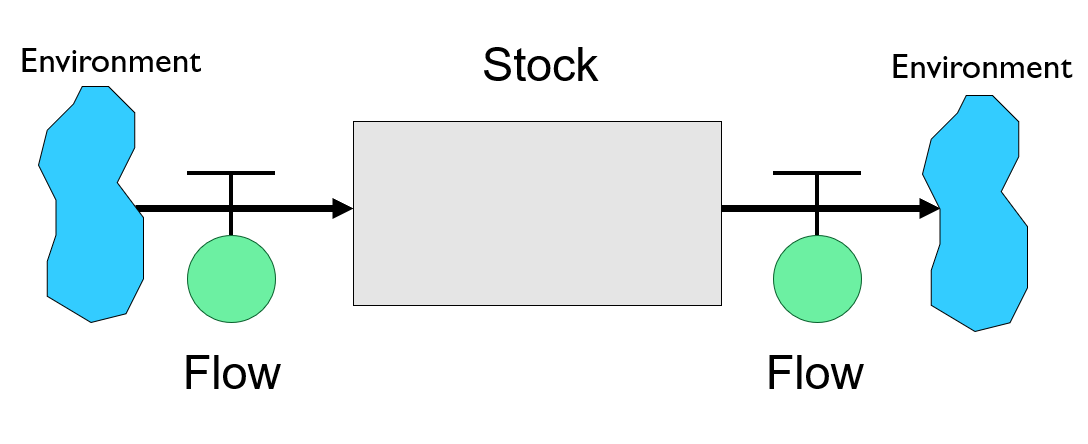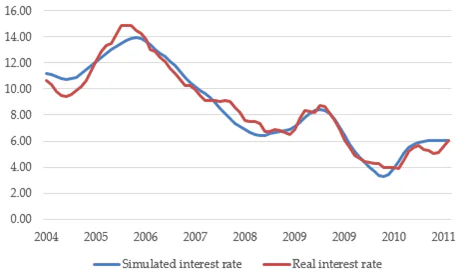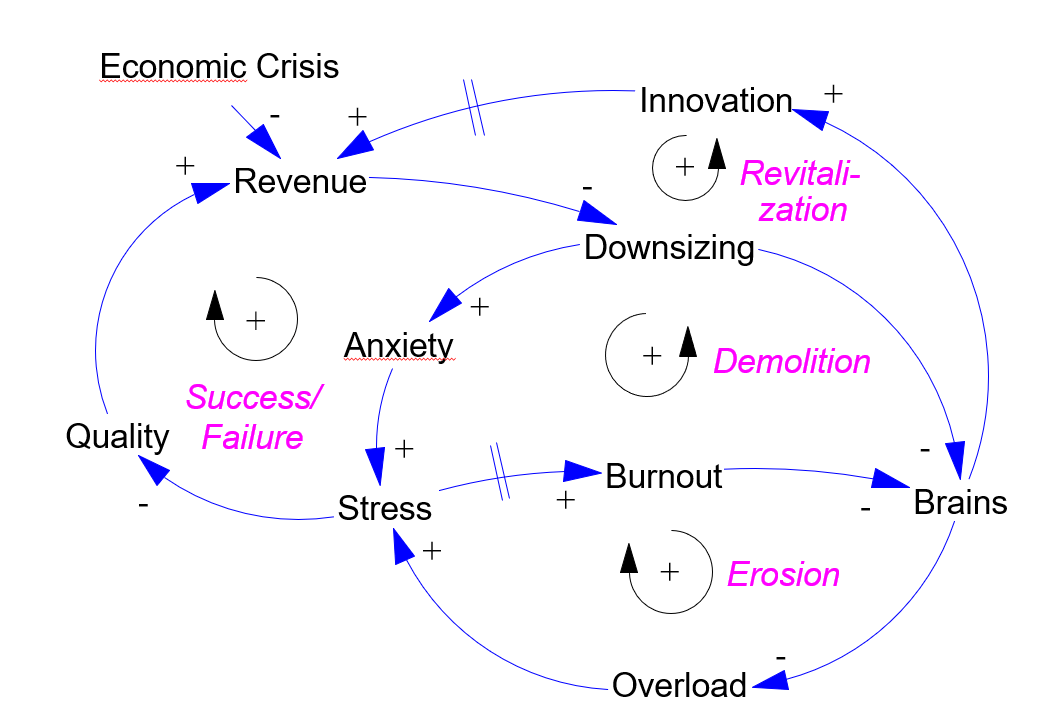System Dynamics Group
The UNISG System Dynamics Group (SDG) is a research group at the Institute of Management and Strategy of the University of St. Gallen, Switzerland. It is dedicated to the modeling, simulation and management of complex, dynamic systems.
About us
System Dynamics
System Dynamics is a discipline for the modeling, simulation and steering of complex, dynamic systems. It provides a sophisticated, generic methodology to model the structure of such systems and to simulate their behavior. This methodology was developed at the Massachusetts Institute of Technology (MIT) by Prof. Jay Forrester. It is used worldwide today.
System Dynamics is unmatched in dealing with dynamic complexity in organizations of all kinds. It can provide deep insights into how they work and enable the development of powerful strategies. The methodology is applicable to dynamic issues in general. It can astonishing learning effects. That is why System Dynamics is not only used for questions in organizations, but also for the modeling and simulation of “big” problems – ecological, social and economic.
UNISG System Dynamics Group
The UNISG System Dynamics Group (SDG) is a group of researchers at the Institute of Management and Strategy of the University of St. Gallen, Switzerland. SDG is dedicated to the modeling, simulation and governance of complex, dynamic systems. It goes back to pertinent research and teaching activities since the middle of the eighties.
The System Dynamics methodology distinguishes itself from other methodologies for the analysis of complex issues. The distinction is in the modeling of feedback structures, and in capturing the nonlinearities of a system’s behavior, which these structures produce. In this context, the inclusion and simulation of temporal delays as well as probabilistic functions play important roles.
The SDG aims at making substantial contributions:
Our Team
Markus Schwaninger, Prof. em. Dr.
Institute of Management & Strategy at the University of St. Gallen
Dufourstrasse 40a
CH-9000 St. Gallen
T +41 71 224 2382
markus.schwaninger@unisg.ch
Stefan Grosser, Prof. Dr.
Professor of Strategy
at Bern University of Applied Sciences
and Lecturer in Management at HSG
School of Management
Brückenstrasse 73
CH-3005 Bern
T +41 31 848 34 54
Evgenia Ushakova, M.A. UNISG
Doctoral Candidate & Research Associate
T +41 79 4338784
evgenia.ushakova@unisg.ch
Methodology
System Dynamics is a methodology for dealing with dynamic complexity by means of modeling, simulation and governance. This methodology is based on the idea that any complex dynamic system can be described by two kinds of variables only: stocks and flows. This is visualized in Figure 1. Please note that the flow variables in this diagram either originate from an environment (inflow to the left) or flow into an environment (outflow to the right). This relationship is not analyzed further here; in other words, the boundary of the system is where the structure of the system represented meets the environment.
The loop shown in the picture consists of auxiliary variables, which feed back on the inflow. Suppose the stock is a population, the births are the inflows and the auxiliary variables represent the economic production of the respective system and the resultant wealth (prosperity), which thereupon reduces the birth rate. Note that the diagram does not contain any proposition if the level of wealth induces a reduction of life span and consequently the size of the population. The diagram also shows parameters, – which in the cited case would be fractional birth and death rates. The closed loop is an image of a system state, which retroacts causally onto itself. This causal process includes delays, as shown by the crossbars.
Besides the nonlinear behavior of the focal variable, the diagram also shows that the simulated values only deviate little from the real values. That speaks for a good quality of the model.
The insights from a simulation project can be carved out meaningfully. For this purpose, the CLDs – Causal Loop Diagrams – have proved their worth. These diagrams are also frequently useful in modeling, – for a phase of model conceptualization or qualitative modeling, which takes place before quantitative modeling. Figure 5 shows the CLD as a tool, by which the model just demonstrated was sketched out, conceptually.
The circular arrows at the center of the loops indicate their polarities. In this case, all loops are of the balancing type (designated with “-“ in Figure 3 and “B” in Figure 5). The polarity results from a multiplication of the signs on the arrows along the loop. A result of “+” or “R” would denote a self-reinforcing loop.
Finally, a small CLD (Figure 6). It is a synthesis of a model, which represents the essential insights from a modeling project.
In the case at hand, a company – due to an economic slump – plans a massive program of layoffs. It is foreseeable that this will lead to a brain drain. With the employees that remain in the company, the downsizing leads to anxiety; burnouts and further dismissals will follow. At the same time, stress at work is growing, inducing more errors and therewith decreasing quality. This results in a loss of earnings.
The loops in Figure 6 again wear labels that describe the basic dynamics. All of the loops in this diagram are of the self-reinforcing type and therefore marked with “+” (or “R”). These are vicious circles, the synergy of which necessarily yields fatal consequences. Is there any escape for that company? With the variable “Innovation” a powerful lever for the recovery of the company is introduced (see diagram). However two difficulties arise: firstly, the need for additional qualified staff, when innovations should be realized, and secondly the substantial delay between an innovative activity and its impact on the earnings.
So far, a brief view on the methodology of System Dynamics, from a stance of factual logic. In addition, questions of chrono-logic – the temporal sequence of activities -, and finally socio-logic – the way communicative processes of modeling have to be designed – need to be considered in SD projects. For example, modeling is always a human-machine process, and today largely teamwork. Besides that, the processes are not alone sequential but in part synchronous.
There is a rich literature about the methodological aspects of System Dynamics. Pertinent research has been realized at our System Dynamics Group. See publications page.
Research
The theoretical activities of the System Dynamics Group UNISG focus on conceptual and methodological topics. Selected projects:
In addition, application-oriented are realized together with organizations from diverse sectors. In these projects, qualitative and quantitative models, or combinations thereof, are built. The purpose of these models is in coping with complex, dynamic issues or problems.
Previous cooperations (Abstract):








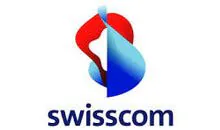
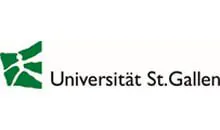
Conferences
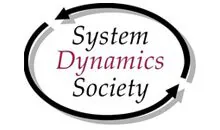
International System Dynamics Conference
The members of the System Dynamics Group UNISG regularly attend the International Dynamics Conferences of the System Dynamics Society, which is the leading professional association in the field. They present scientific paper and contribute to plenaries.
In 2023 the conference takes place on July 23 – 27 in Chicago, USA .
The System Dynamics Group UNISG has been organizing several further meetings, e.g., the stream on System Dynamics Modeling and Simulation at EURO – the European Conference on Operational Research, the European System Dynamics Workshop, Roundtables and inter-university doctoral seminars in System Dynamics.
Publications
Books, Dissertations and Monographs
- Schaffernicht MFG, Groesser S N (2018) Growth Dynamics in New Markets: Improving Decision Making through Model-Based Management. Chichester: Wiley.
- Hoffmann, C. H. (2017 ). Effectively Ineffective : assessing the efficiency seeking management of risks : towards alternative risk measures for complex financial system. St. Gallen: Universität St. Gallen, Dissertation Nr. 4664.
- Schwenke M (2016) Management Tools for Strategizing: Opportunities and Challanges for Accepting and Implementing Dynamic Tools. PhD Thesis No 4562. St. Gallen: University of St. Gallen
- Ushakova E (2014) Print-to-Online Transformation: a System Dynamics View on News Media Business Models. Master thesis. St. Gallen: University of St. Gallen.
- Grösser SN, Schwaninger M, Tilebein M, Fischer T, Jeschke S (2014) Modellbasiertes Management. Berlin: Duncker & Humblot.
- Grösser SN (2013) Co-Evolution of Standards in Innovation Systems. The Dynamics of Voluntary and Legal Building Codes. Berlin: Physica-Verlag.
- Grösser S N, Zeier R (2012) Systemic Management for Intelligent Organizations: Concepts, Models-based Approaches and Applications. Berlin: Springer.
- Hoffmann CH (2017) Effectively Ineffective : assessing the efficiency seeking management of risks : towards alternative risk measures for complex financial system. St. Gallen: Universität St. Gallen, Dissertation Nr. 4664.
- Schwaninger M (2009) Intelligent Organizations: Powerful Models for Systemic Management (Second ed). Berlin: Springer.
Journal Arcticles
- Schoenenberger L, Schmid A, Tanase R, Beck M, Schwaninger M (2021) Structural Analysis of System Dynamics Models. Simulation Modelling Practice and Theory, Vol. 110: 1-19, doi: https://doi.org/10.1016/j.simpat.2021.102333282.
- Schwaninger M (2018) Systemic Design for Sustainability. Sustainability Science, Volume 13(5): 1225-1234. https://doi.org/10.1007/s11625-018-0538-5
- Schwaninger M (2017) Komplexität systemisch meistern. Wirtschaftsinformatik & Management. April 2017, Volume 9, Issue 2: 20–21.
- Schoenenberger L, Schmid A, Ansah J, Schwaninger M (2017) The Challenge of Model Complexity: Improving the Interpretation of Large Causal Models through Variety Filters. System Dynamics Review, 33(2): 112-137.
- Schaffernicht M, Groesser SN (2014) The SEXTANT Software: A Tool for Automating the Comparative Analysis of Mental Models of Dynamic Systems. European Journal of Operational Research.
- Groesser SN, Schwaninger M (2012) Contributions to Model Validation: Hierarchy, Process, and Cessation. System Dynamics Review, 28(2): 157-181.
- Groesser SN, Schaffernicht M (2012) Mental Models of Dynamic Systems: Taking Stock and Looking Ahead. System Dynamics Review, 28(1): 46-68.
- Schwaninger M, Groesser S (2008) System Dynamics as Model-Based Theory Building. Systems Research and Behavioral Science, 25: 447-465.
- Schwaninger M, Pérez Ríos J (2008) System Dynamics and Cybernetics: A Synergetic Pair. System Dynamics Review, 24 (2): 145-174).
Book Chapters
- Schwaninger M (2020) System Dynamics in the Evolution of the Systems Approach. In: Dangerfield B (ed) System Dynamics.Theory and Applications. A Volume in the Encyclopedia of Complexity and Systems Science. Second Edition. Springer, New York: 21-39.
- Schwaninger M, Groesser S (2020) System Dynamics Modeling: Validation for Quality Assurance In: Dangerfield, Brian (ed.) System Dynamics.Theory and Applications. A Volume in the Encyclopedia of Complexity and Systems Science. Second Edition. Springer, New York: 119-138.
- Schwaninger M, Klocker J (2018) Efficiency versus Effectiveness in Hospitals: A Dynamic Simulation Approach. In: Borgonovi E, Anessi Pessina E, Bianchi C (eds) Outcome-Based Performance Management in the Public Sector. Berlin: Springer: 397-424.
- Schwaninger M, Klocker J (2017) Systemic Development of Health Organizations: An Integrative Systems Methodology. In: Qudrat-Ullah H, Tsasis P, eds. Innovative Health Systems for the 21st Century. Cham, Switzerland: Springer International: 87-139.
- Groesser S (2015) Lab or Reality: Entwicklung und Analyse von Geschäftsmodellen durch das kybernetische Unternehmensmodell Blue Company. In Jeschke S, Schmitt R, Dröge A (eds), Exploring Cybernetics – Kybernetik im interdisziplinären Diskurs. Berlin: Springer: 110-135.
- Schwaninger M, Ambroz K (2010) Plädoyer für Langfristorientierung. In: Strohhecker J, Grössler A. (ed.): Strategisches und operatives Produktionsmanagement. Empirie und Simulation. Wiesbaden: Gabler: 23-46.
- Schwaninger M, Janovjak M (2009) Innovative Models for Steering Organisations: A Systemic Approach Within the Pharmaceutical lndustry. In: Jonker, J., Eskildsen, J. (eds.): Management Models for the Future. Heidelberg, Springer: 13-32.
- Schwaninger M (2008) Saving a Valley: Systemic Decision-making Based on Qualitative and Quantitative System Dynamics, in: Qudrat-Ullah, H., Spector, J. M., Davidsen, P. (eds.): Complexity in Decision Making. Theory and Practice. Heidelberg: Springer: 211-226.
Conference and Dissertation Articles
- Schwaninger M (2018) Anticipating the Unexpected: Simulating a Health Care System Showing Counterintuitive Behavior. In: Moreno-Díaz, Roberto; Pichler, F., Quesada-Arencibia, A. (eds.) Computer Aided Systems Theory – EUROCAST 2017: 220-227.
- Boyarskaya T, Ushakova E (2014) A Systems Approach to Business Strategy: The Case of Chocolate Production. Discussion Paper No. 59, Institute of Management at the University of St. Gallen.
- Schwaninger M, Groesser SN (2013). Escaping the Linearity Trap: Better Simulation Models for Management Support. In R. Moreno-Díaz, F. Pichler & A. Quesada-Arencibia (Eds.), Computer Aided Systems Theory – EUROCAST 2013 (Vol. Part I, LNCS 8111). Berlin: Springer: 92-101.
- Schwaninger M, Groesser SN (2010) Crisis prevention – What Is Necessary to Avoid the Next Crisis? In R. Trappl (Ed.), Cybernetics and systems 2010 – Proceedings of the 20th European Meeting on Cybernetics and Systems Research. Vienna: Austrian Society for Cybernetic Studies: 315-320.
- Schwaninger M, Grösser S (2009) New Frontiers in the Validation of Simulation Models – Structural Dominance Analysis. In: Roberto Moreno-Diaz, Franz R. Pichler, Alexis Quesada-Arencibia (Eds.) Computer Aided Systems Theory – EUROCAST 2009, Berlin, Springer: 53-62.
- Schwaninger M, Groesser SN (2008) Modeling as Theory-Building. In: Proceedings of the 26th International Conference of the System Dynamics Society. Athens, Greece: 1-26.
- Schwaninger M, Ambroz K (2010) A Plea for Long-term Orientation in Organizations, in: Dubois, Daniel M., ed., Computing Anticipatory Systems CASYS’09, Melville, New York: American Institute of Physics: 434-443.
